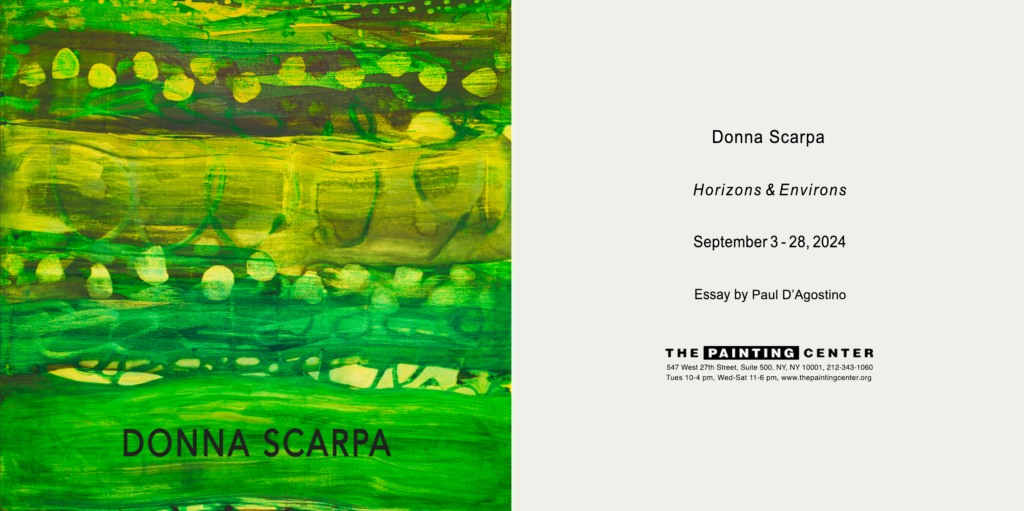Exhibition Catalogue & Essay
Intimacy and Light in Horizons & Environs
by Paul D’Agostino
Donna Scarpa’s recent paintings showcased in Horizons & Environs constitute a chromatically vibrant, compositionally enlivened suite of works that buzz, brim, and burst with aesthetic freshness. Wholly palpable in these zestful compositions is the artist’s unfettered enthusiasm for varied approaches to abstract formalities and nature-inspired subjects alike – and for charting new territory in her ongoing investigations of the revelatory potential of pictorial light.
Scarpa’s compositional treatments are matters of layerings, imbrications, diffusions, interlacings, and subtle, nimbly rendered interventions. Consistent in her practice are calmly meandering, patently gestural marks, ostensibly laid down by way of prolonged yet unlabored passages with loaded brushes, and variable modes of material translucency that allow the bright hues of nether layers to peer through overpaintings, and that create an overall sense of lightly handled luminosity. Relatively heavier uses of texture occasionally factor into the artist’s surfaces as well. These serve to variegate and enrich the compositions in select areas, and to accentuate the limpidity of the more liquid registers with which the textured patches converge and commingle. Also generally consistent in Scarpa’s practice are uses of wide ranges of expressive, carefully determined palette combinations, a tendency to work on multiple paintings at various scales all at once, and an enduring predilection for seeking cues for abstraction in the natural environment.
Scarpa’s references to landscapes, plants, and the shifting atmospherics of our shared habitats most broadly understood are evocative as opposed to illustrative, whispered or implied as opposed to stated or described. Such are the utterances of spirited ‘environs’ in the artist’s new body of work. As for the ‘horizons’, these too collapse notes of the literal into hints of the metaphorical. Scarpa’s preferred mark-making gestures in the thrust of her recent works manifest as markedly horizontal, even while many of her surfaces are proportionally square or vertical. As such, her horizontal interventions, with the motion of the artist’s hand ever present, scan as strata, bands, and layered stacks of color, occasionally interlaced with or accented by variably conspicuous arcing, vertical, dashed, or dotted marks to suggest lattices, loops, links, lobes, sieves, spots, and textile-like weavings. In some works, Scarpa’s horizontals imply actual horizons, such as in the effulgently sizzling duo Earth, Wind, Fire and Horizon, where choice horizontal stretches scan as indirect indications of horizon lines tucked into ambiguously perceptible, thermally radiant landscapes. Also ranking highly in Scarpa’s thermal index is Solar, where fiery vertical striations of saffron and apricot orange hues overlay, intersect, and line up with an undergirding of scant horizontal vestiges of green and purple, and where boldly drawn, gently arcing delineations tumbling down the left register recall the curved and rounded forms of Walking on the Moon, while also echoing the energetically brushy, blazing cycles of marigold loop-de-loops dancing about in Chakras. Meanwhile, in works such as the synergetic Glow, the mesh-like Glimmer, and the formally elusive Mirage, horizontal intimations embedded into surfaces or surging to the fore arouse poetically enigmatic notions of ‘horizons’ – intuitable, perhaps, as limits to awareness or knowledge, or as uncertain transmissions of nebulous beyonds.
Loosely gestural, chromatically striated, and variably textured horizontalities in Scarpa’s paintings sometimes also point to quite specific features in or visions of the natural environment. The robustly rendered bands of warm oranges, ruddy greens, varied ambers, and deep umbers in Earthen, for example, might be seen as hills and valleys beneath a dusky sky, or as demarcations of field after field of fertile farmland, or even as immemorial strata in a prodigious extrusion of minerally rich sedimentary deposits. In Midnight Rain – which might be viewed as the setting of Earthen glimpsed during a nocturnal storm – thinned hues of ultramarine blue and somewhat pale cerulean obscure a vaguely discernible background of organics being drenched in a downpour. Whereas those works evince a sense of zooming out, as it were, or regarding from a certain remove, other compositions seem to probe their subjects more closely by zooming in. The vacillating horizontals of striking greens and intermittent yellows in Moss and Bamboo, for instance, suggest the vital chromatics of not only their eponymous subjects, but also of all manner of other kindred fungi, thalli, shoots, and lichens – all as if subjected to close-up, undeviated observation. In works where somewhat thicker textures lend distinct visual grip to their surfaces, the tangibility of painterly facture translates to tangibility of painted objects as well. In the sweetened golds of Honeybee, it seems as though an oozing honeycomb from a beehive or apiary is what’s most immediately present before our eyes. And in Dune, soft undulations of herbaceous and seafoam greens create aspects of wispy grasses in their titular perch, swaying about shiftily in their sandy hillock substrate. Above this shoreside mound, then, we glimpse a soft jade sky suffused with hints of azure – a sure sign of an auspiciously placid, remote horizon.
Vigorous and vivid, intensely lucid and rife with life, Donna Scarpa’s paintings in Horizons & Environs mediate the sensations of mirthful solace the artist attains from the world around her. They invite viewers to join her in hiking through the woods, strolling along the beach, walking around the neighborhood, or standing still whilst gazing up at the sky, all the while registering the vicissitudes of light and natural curiosities of their surroundings. Although horizons are often matters of metaphorical and geographical distances, Scarpa abstracts them from her quotidian environs to reveal them with joyful, luminous nearness, rendering them pictorially proximal, stirringly intimate.
– Paul D’Agostino, Ph.D. is an artist, writer, educator, curator, and translator. He is Writing and Thesis Advisor for the MFA program at The New York Studio School, and a regular visiting critic and instructor for several other institutions and residency programs. D’Agostino teaches writing workshops, is a translator and editor working in various languages, and writes about art, books, and film on a freelance basis.
